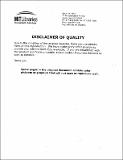Stress evolution during growth and atomic-scale surface structure effects in transition-metal thin films
Author(s)
Friesen, Cody A. (Cody Alden), 1978-
DownloadFull printable version (10.53Mb)
Other Contributors
Massachusetts Institute of Technology. Dept. of Materials Science and Engineering.
Advisor
Carl. V. Thompson.
Terms of use
Metadata
Show full item recordAbstract
Thin films are defined by an extremely high ratio of the in-plane dimensions to the thickness, resulting in very high surface-to-volume ratios. For this reason, the surface characteristics of a film play an important role in the properties of the film as a whole. This research focused on the connections between the properties and the surface state of metallic thin films. High resolution in-situ stress measurements were made during the ultra-high vacuum evaporative deposition of polycrystalline Cu films and homoepitaxial (111)-oriented Cu and Ag films. The measurements were enabled through the development of two high resolution in-situ stress monitoring devices that minimized sample placement and vibrational error through compact and monolithic ultra-high vacuum compatible designs. These devices allowed in-situ stress measurements with unprecedented sensitivities while the device electronics enabled the study of systems in real-time with high data acquisition rates. Measurements were made during growth and interruptions of growth as the films formed and thickened. In the earliest stages of a growth cycle, when only a small fraction of a monolayer is deposited, the elastic component of the adatom-surface interaction dominates the stress evolution. The early stage observations are analyzed through a first- order expansion of the thermodynamic surface stress which allows for direct extraction and measurement of the force-dipole associated with the adatom-surface interaction. (cont.) Values of the force-dipole magnitude determined from experiments compared well with values obtained from embedded atom method molecular dynamics calculations. On a longer timescale, evolution of the atomic-scale surface roughness was tracked using reflection high energy electron diffraction (RHEED), and a strong correlation with the measured stress changes was found. Significant portions of both the stress and surface roughness changed reversibly upon interrupting and restarting the growth. These results demonstrate that reversible stress changes observed during interruptions of the growth of polycrystalline and epitaxial films are due to a far-from-equilibrium atomic scale surface defect concentration present during growth. In-situ stress measurements were also made during heteroepitaxial growth in several metallic systems: Ag/Au(1 11), Cu/Au(1 11), Pt/Au(l 11), Al/Au(l 11), Ag/Cu(1 11), Ag/Pt(111), and Ag/Al(111). Each system has different lattice misfits and different relative electronic structures, leading to a large range of stress and structure evolution phenomenology. In all cases the large stress changes observed at the very beginning of growth were influenced by both misfit strain and chemical differences, with the latter often dominating. Stress evolution during continued film thickening was also always more complex than the behavior expected for epitaxial misfit and dislocation-mediated relaxation of epitaxial misfit. As was the case for Volmer-Weber growth of polycrystalline films and for homoepitaxial growth, transient defect concentrations lead to large reversible stresses in these systems during growth interruptions ...
Description
Thesis (Ph. D.)--Massachusetts Institute of Technology, Dept. of Materials Science and Engineering, 2004. Includes bibliographical references (v.2, leaves 267-272).
Date issued
2004Department
Massachusetts Institute of Technology. Department of Materials Science and EngineeringPublisher
Massachusetts Institute of Technology
Keywords
Materials Science and Engineering.